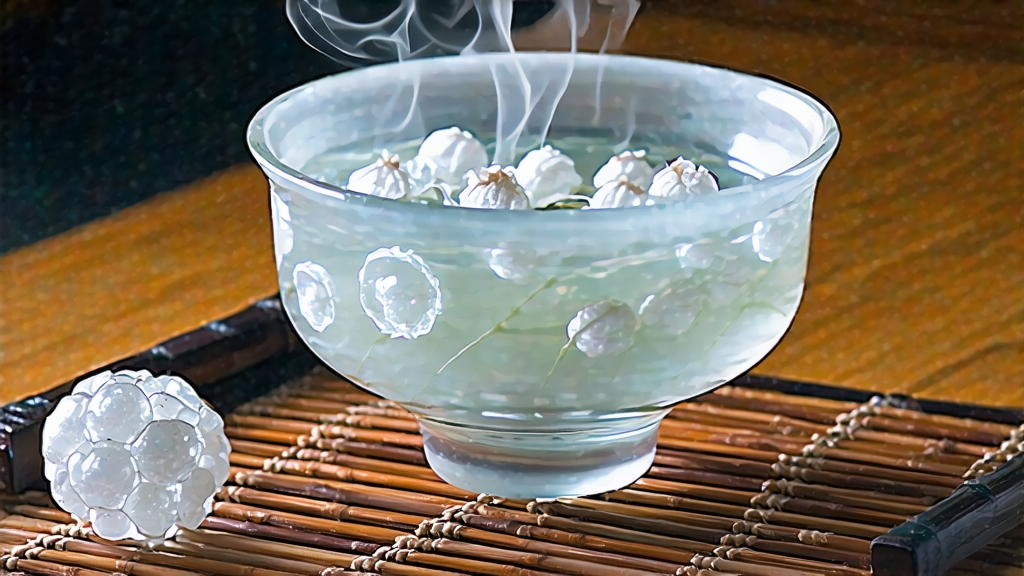
White Hair Silver Needle—Bai Hao Yin Zhen in its native name—is the most aristocratic expression of Chinese white tea. To the uninitiated it may look like a jar of slender, silvery twigs, yet once hot water kisses those down-covered buds they uncurl into miniature fireworks of aroma, releasing the cool scent of fresh rain on hay, melon rind, and the faintest trace of alpine orchid. Understanding this tea is less a lesson in agriculture than an invitation to slow down and taste the Chinese philosophy of wu-wei: action through non-action, flavor coaxed rather than forced.
-
Historical whispers
The first written record of “white tea” appears in Song dynasty treatises of 1064 CE, but those documents refer to a compressed cake made from tender leaves, not the loose-needle style we know today. Silver Needle proper emerges during the late Qing, when the imperial court still demanded tribute tea from Fujian. Legend claims that only buds ploked at dawn, before the mountain mist lifted, were deemed worthy of the empress dowager’s porcelain. Whether apocryphal or not, the story cemented the idea that Silver Needle is plucked, processed, and appreciated with ritual precision. -
Terroir: two counties, two personalities
Authentic Silver Needle hails almost exclusively from Fujian province—either Fuding in the northeast or Zhenghe in the interior. Fuding’s coastal air, mineral-rich red soil, and long, foggy springs yield needles that are plumper, paler, and famously sweet. Zhenghe sits at slightly higher elevation; its cooler nights and shorter growing season produce slimmer, jade-tinged buds with a deeper, more herbaceous cup. Both styles share the same cultivar—Da Bai Hao (“Big White Down”)—yet speak in different accents the way Chablis and Meursault both begin with Chardonnay. -
Craft: the art of doing almost nothing
White tea’s minimalism is deceptive. After picking, the buds are spread on bamboo trays exactly one finger-width apart so that air can travel beneath them. For 36 to 48 hours they rest in a shaded pavilion, protected from direct sun yet open to mountain breezes. No pan-firing, no rolling, no shaking—only a gradual loss of moisture that concentrates amino acids and preserves the tiny white hairs that give the tea its name. When the moisture content drops to 8–10 %, the needles are transferred to a charcoal-warmed room for “soft baking” at 40 °C, a step that stabilizes the leaf without adding roast flavor. The entire cycle is watched like a sick infant; too much wind and the buds redden, too little and they sour. Mastery lies in knowing when inactivity becomes perfection. -
Grades and micro-batches
Unlike green or oolong, Silver Needle is rarely blended. Each garden’s daily pick is processed separately, creating micro-lots that can vary astonishingly. The top grade, “Imperial,” consists entirely of unopened buds 2.5–3 cm long, coated in such dense down that they shimmer like hoarfrost. “Standard” grade allows 5 % open leaves, while “Common” may contain broken tips or stems. Connoisseurs track not only county but also mountain ridge, altitude, and even the lunar calendar; buds plucked on the first ten days after Qingming festival are said to carry the clearest qi. -
Brewing: the gentle reveal
Silver Needle is forgiving, yet it rewards patience. Begin with 4 g of leaf—about two heaping teaspoons—in a 200 ml glass or gaiwan. Use water just off the boil, cooled for two minutes to 85 °C; hotter temperatures scorch the down and flatten the aroma. The first infusion should last 45 seconds, just long enough for the buds to stand upright like tiny ivory pagodas. Pour slowly, keeping the stream low to avoid frothing the delicate hairs. Subsequent steeps add ten seconds each; a quality lot will deliver five fragrant cups, the third being the most balanced. If you own a tall double-walled glass, watch the buds drift in slow motion—a visual haiku that justifies the Chinese saying “one leaf knows the world.” -
Sensory lexicon
On the nose, dry Silver Needle suggests fresh wheatgrass, steamed edamame, and